Best Soil For Christmas Cactus (Potting Mix Recipe)
Learn all about the best soil for Christmas cactus and how to make your own soil mix right here!
A Christmas cacti brings colorful bright flower blooms during the holiday season. When well cared for, these holiday cacti are wonderful indoor plants that produce dozens of flower buds in mid winter.
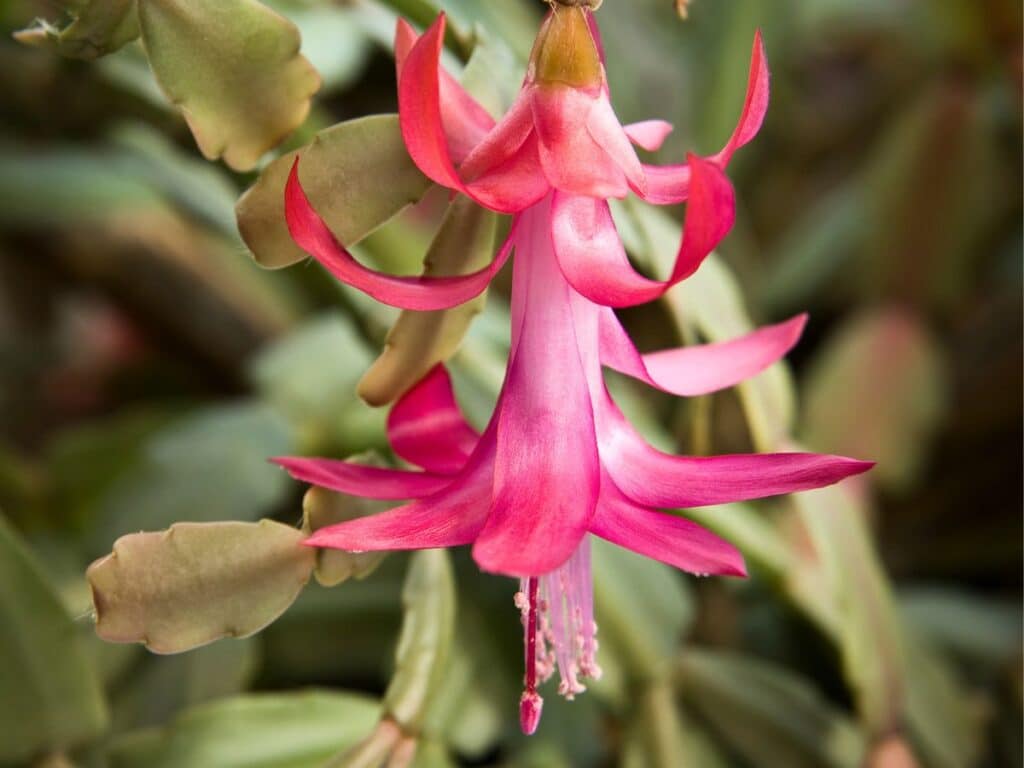
This post contains affiliate links, and we may make a small commission if you use them. Thank you!
They can live for decades (even up to 100 years), so these succulents are well worth investing time and care into!
But the right soil for these tropical plants is one of the most important factors for plant health and bloom production.
Christmas cactus plants must have a loose, slightly acidic, well-draining soil medium and drainage holes in the bottom of the pot to prevent too much water from sitting on the roots.
The wrong soil can cause major problems for your plant; from fungal gnats and limp leaves to root rot, and in severe cases even plant death! So, it’s important to get the growing medium just right for your plants!
Key Takeaway: When it comes to soil for holiday cactus, good drainage is of upmost importance. The soil must be kept moist, full of nutrients, and able to drain very quickly!
If we haven’t met, my name is Jamie and I’m a life long plant enthusiast. I’ve been growing houseplants for over a decade, and I’m excited to share with you my experience growing these gorgeous cactus today.
Natural Growing Environment + Soil
Christmas cactus (Schlumbergera x buckleyi) and Thanksgiving cactus are part of the Schlumbergera genus.
Due to their festive bloom times, they are often referred to as holiday cactus. (Easter cactus has also been historically classified in the same genus).
Though they are different plants, these two holiday cacti require the exact same growing conditions, so you can apply these soil tips to both types!
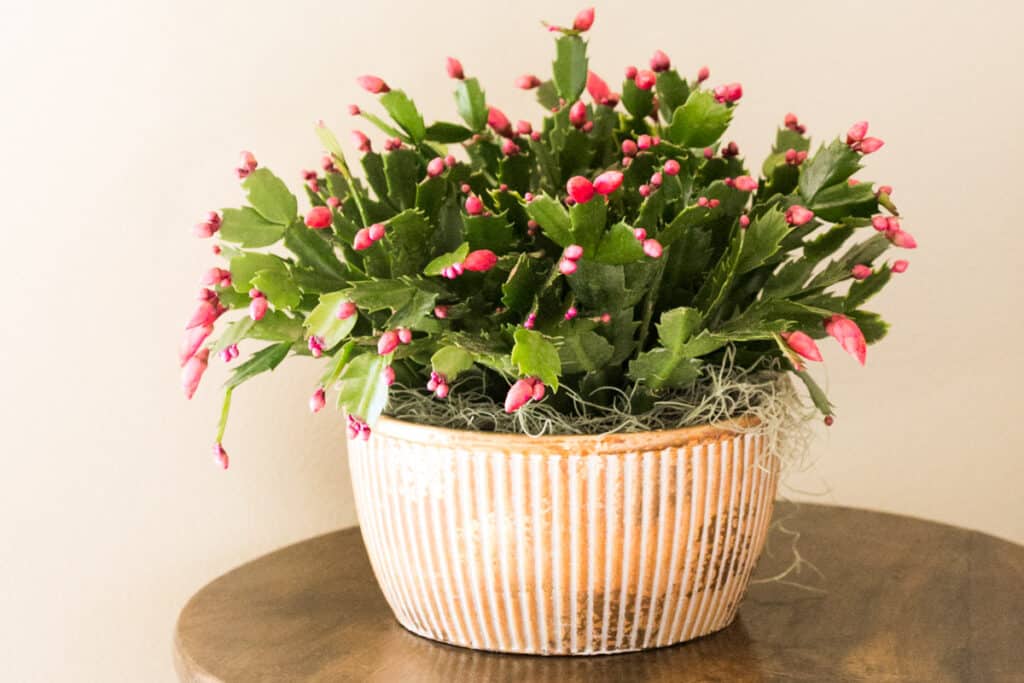
These beautiful cacti hail from the rain forests of Brazil, where they grow as epiphytic plants- a plant that grows on the surface of another plant.
According to the Master Gardeners of Butte County, they grow on mossy branches or in rocky nooks filled with decayed vegetation.
In these tropical habitats life is shady with moderate temperatures, and the plant receives bright indirect light, moderately high humidity, and a soil substrate that is moist but well draining.
Christmas cactus use their roots to pull nutrients from the decaying matter they live on, and because they are positioned higher up, excess water drains quickly from their roots.
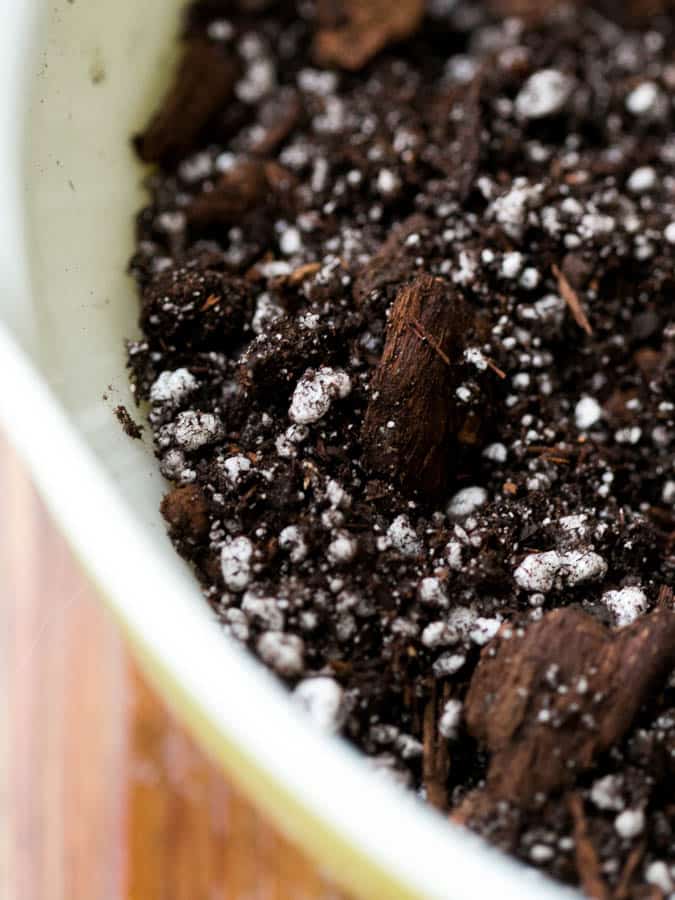
This unique growing environment must be mimicked when growing Christmas cactus as indoor plants. When given great soil similar to their native environment and proper care, your Christmas cacti will thrive.
A heavy potting soil without great aeration will essentially cause your plant to suffocate, limiting it’s ability to pull nutrients and water from it’s environment.
Supplies You May Need
As houseplant enthusiasts we keep many of these supplies on hand. But you may need to pick up these supplies for your Christmas cacti:
- Perlite
- Orchid Bark
- Potting soil
- Container with drainage holes (size dependent on your plant)
- pH meter
- Houseplant specific watering can
Elements Needed In Christmas Cactus Soil
Holiday cacti need soil that with that has great drainage, is slightly acidic and nutrient rich:
Great drainage
Both Thanksgiving cacti and Christmas cacti tend to grow higher up, dangling down from other trees, rocks or plants. Because of this, their roots are adapted to absorb moisture quickly and easily from an extremely fast draining soil medium. Make sure the potting soil you use at home also has fast draining qualities.
Worried you may be overwatering your holiday cactus? Read this!
Slightly acidic
The decaying matter in the natural growing environment of these cacti is slightly acidic, with a pH range of 5.5-6.2. The growing medium used for Christmas or Thanksgiving cactus should also have this same acidity. Use a pH meter to test the level. (If you use the cactus formula below, the acidity should be in the right range).
Nutrient rich
In it’s native environment, a Christmas cactus will glean nutrients from the decaying organic matter in it’s environment. Therefore, the potting soil for an indoor plant must also have some quality nutrients.
Did you know? True Christmas cacti are hard to find in stores, though they can sometimes be found in specialized nurseries. Because of this, they are often passed down from friends and family members as new plants started from a more established cacti.

This post contains affiliate links. If you click through and make a purchase, we may make a small commission at no extra cost to you.
Best Soil For Holiday Cactus
Successful soil mixes blend a ratio of regular indoor potting soil with well draining materials such as orchid bark, pumice, sand, or perlite.
Here are the elements we are using:
Potting Soil
The decaying bark and plant matter found in the native home of these succulents will be rich in organic matter that is full of vitamins like nitrogen, phosphorous and potassium. Choose a quality potting soil rich in organic matter to supply these nutrients to your plant.
Worm castings can also be used.

Orchid bark:
Orchid bark is a versatile, chunky material that prevents soil compaction and aids in great drainage. It is long lasting and helps soil moisture retention.

Pumice:
Pumice is a naturally occurring aggregate that encourages aeration of roots and increases soil drainage. This essential ingredient also has trace minerals and helps prevent root rot.

How To Make Christmas Cactus
This Christmas cactus soil recipe is perfect for your holiday succulents. The different sizes and textures of this home-made potting soil help ensure excellent drainage, and the materials used will help achieve the right pH level.
Here is an easy Christmas or Thanksgiving cactus soil recipe, with ratios of each material to use included:
- 1 cup potting soil for indoor plants
- 2 cups pumice
- 2 cups orchid bark, featuring small chips
Blend these ingredients well before potting you cactus- we just used our hands to mix the ingredients well.
You will notice that the ingredients needed for drainage are twice that of the potting soil. This is because of the high need for excellent drainage that holiday cactus have.
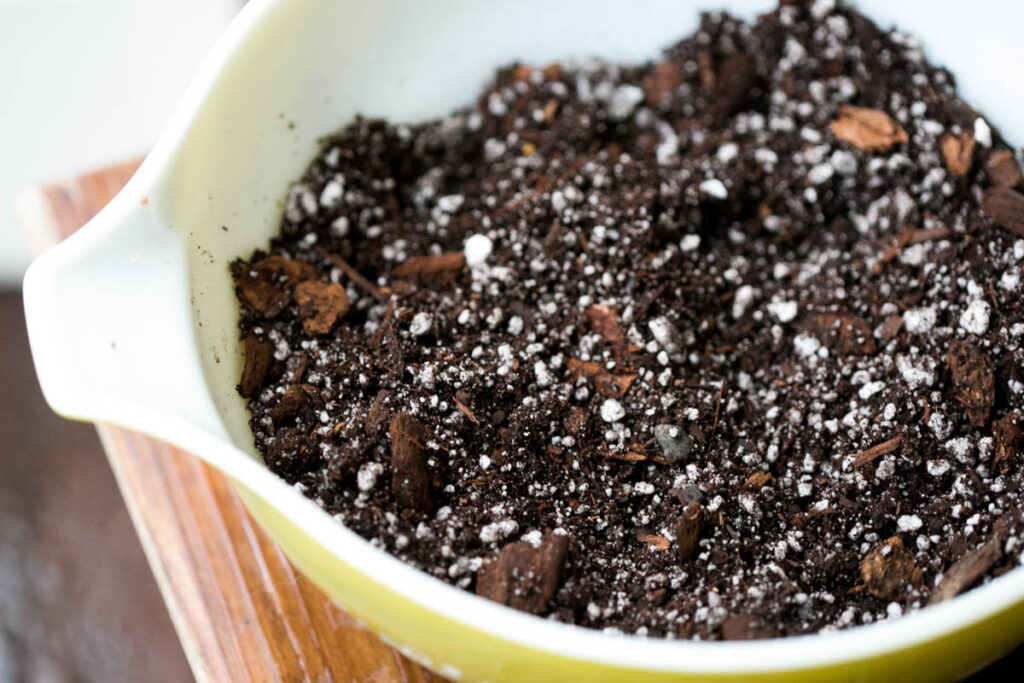
Good Drainage + Container Type
Christmas cactus must have great soil drainage in order to thrive, and the container is an essential part in aiding drainage.
The container material does not matter so much for your cacti- but the holes in the bottom of the container do matter! Make sure that there are adequate drainage holes in the bottom of the pot. Without this drainage, moisture will quickly build up and cause the roots of your plant to rot.
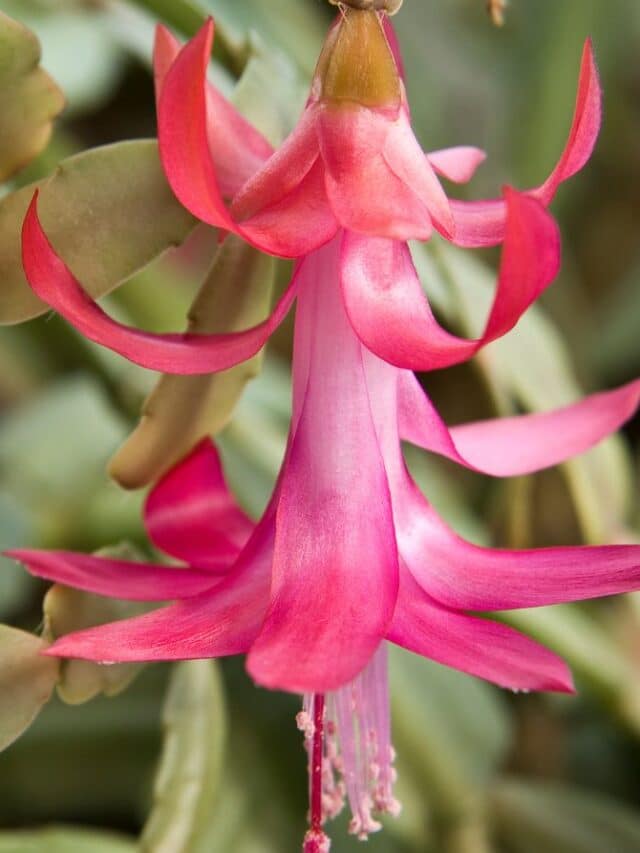
Water sitting on the roots of Christmas cactus will cause all kind of problems: bacteria and fungus will grow which encourages root rot. In turn, fungus gnats will be attracted to the putrid soil.
If you’ve purchased a cactus from the store, check to make sure that it is not double potted. A festive holiday container will often be on the outside, with a functional pot within.
In this situation water will sit within the two containers and encourage rot, so be sure to remove the cacti from the decorative pot before watering, let it drain, and then insert it back into the pretty container.
Learn how to grow and care for Christmas cactus here!
Container Size + When To Repot
These holiday succulents actually enjoy being root bound, so do not re pot them until you see roots growing out of the bottom of the container.
Never repot during flower production and wait until the succulent is completely done flowering, in late winter.
In order to give holiday cactus the tight growing conditions they crave, the new pot should be just one size larger than their current container.
These succulents have shallow root systems, and they do well in tight growing conditions and enjoy being slightly root bound.
When re potting your plant, first replace the soil with your custom potting mix. Then, use a pot just one size up from the current container.
Common Problems With Soil
There are several soil related problems that can occur with Christmas cactus. These problems affect the plant’s health and their ability to produce new blooms during the flowering season:
Root Rot
Root rot is a common problem for indoor plants that occurs when too much water sits on the roots, encouraging fungus growth. Signs of root rot can be wilted or mushy leaves, black spots, and foul smelling soil. Prevent root rot in these cacti plants by giving them soil that drains very well and not over watering.
Wilted Leaves
Wilted leaves can be a sign that the roots are not able to uptake the nutrients in the plant. This can be due to drainage problems with compacted soil, or lack of watering.
Leaf Discoloration
Leaf discoloration can occur for many reasons, from cold temperatures to too much sun. But poor soil quality and sick roots can also lead to leaf discoloration.
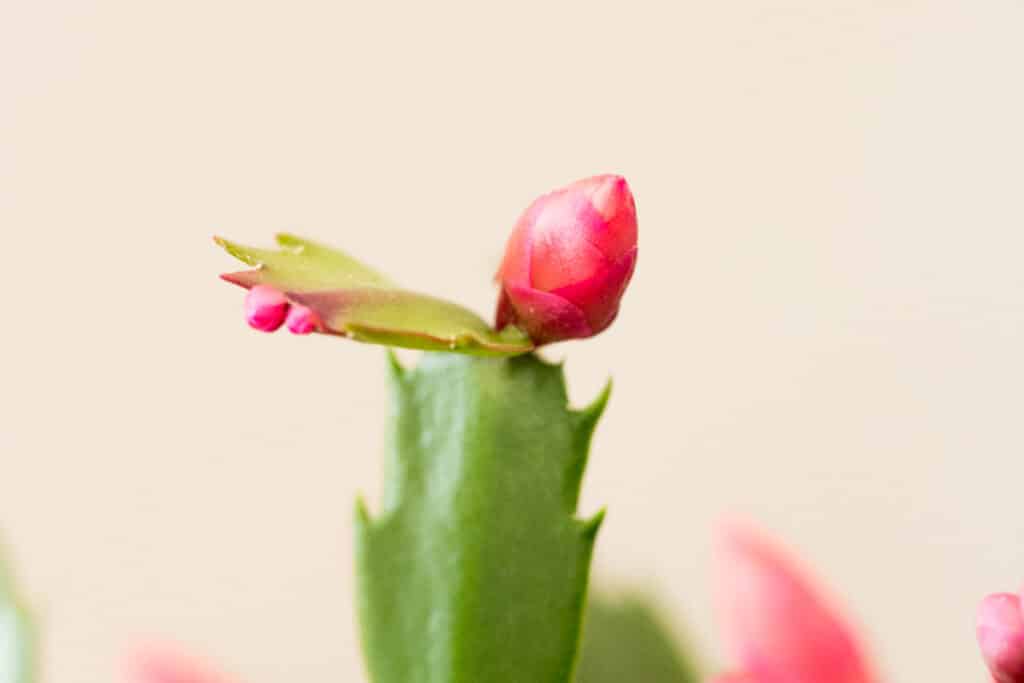
General Care For Holiday Plants
In addition to well draining, slightly acidic soil, Christmas cactus need a few other specific conditions in order to thrive:
- Holiday cacti must have bright, indirect sunlight in order to thrive. Direct light can cause their leaves to burn and turn purple.
- Water Christmas cactus deeply when the soil is dry, then wait until it dries out again to water
- As a tropical plant, they crave a higher humidity level, around 50-60%.
- As a short day plant, both Christmas and Thanksgiving cactus will need 12-15 hours of darkness a day in order to bloom.
FAQ
Regular potting soil for the garden should never be used for Christmas cactus, and indoor potting soil should not be used for holiday cacti by itself. Christmas cacti need a porous, well draining soil that features a variety of materials to increase drainage. Look for soil mixtures that feature pumice, small chip orchid bark, sand and/or perlite.
Yes, holiday cacti do like to be root bound. That being said, there comes a point where they can no longer uptake nutrients and water and need to be repotted. This is when the plant no longer rehydrates after watering, or you see roots growing out the sides or bottom of the container.
Final Thoughts
The most wonderful time of the year can be made even more spectacular with the beautiful blooms of a Christmas cactus. But these plants need great care in order to thrive and produce their vibrant tubular flowers.
Give them proper drainage, a nutrient rich soil, and an acidic pH and they will thrive.
Please feel free to leave any questions or comments below. I read every comment and will try to help you trouble shoot in any way I can!

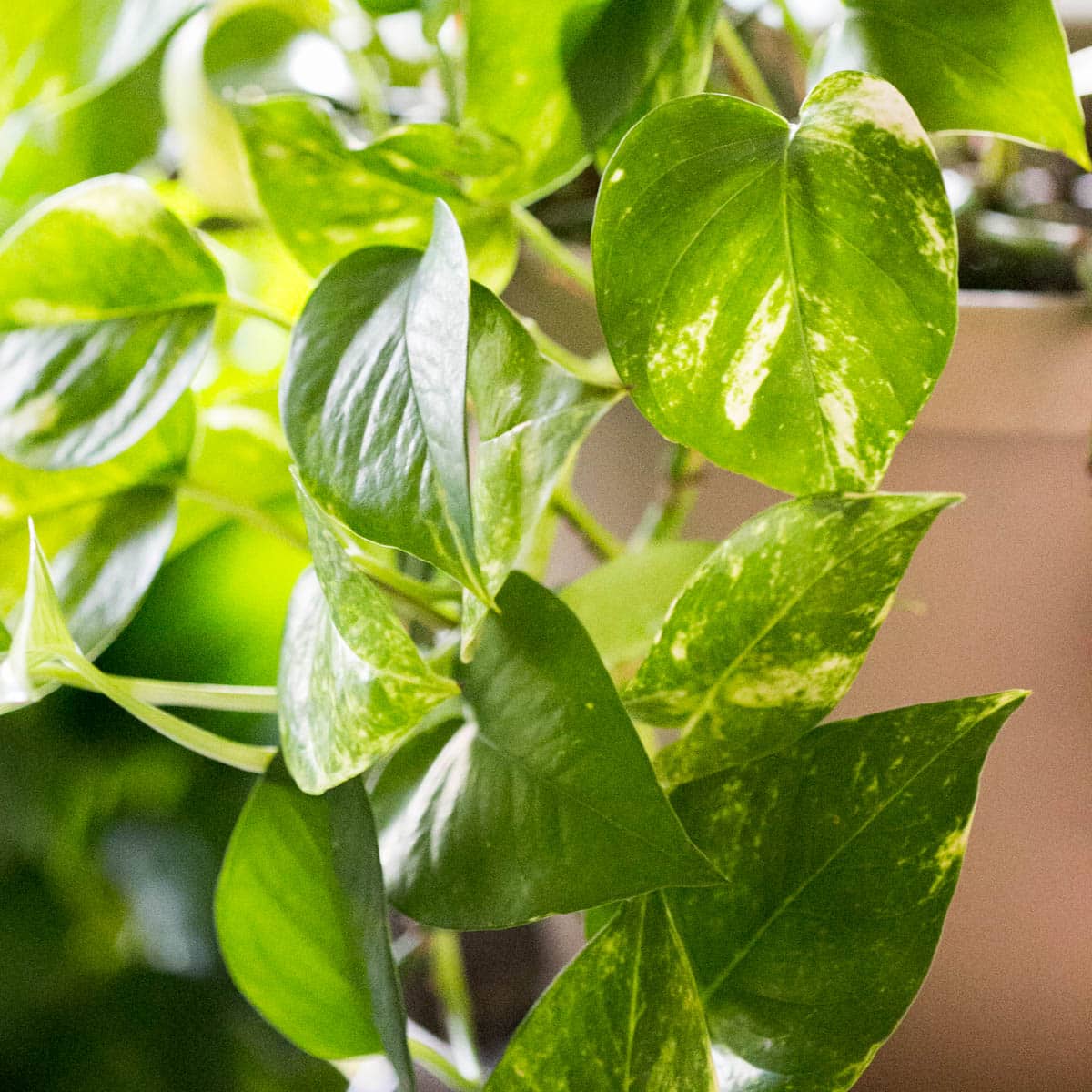
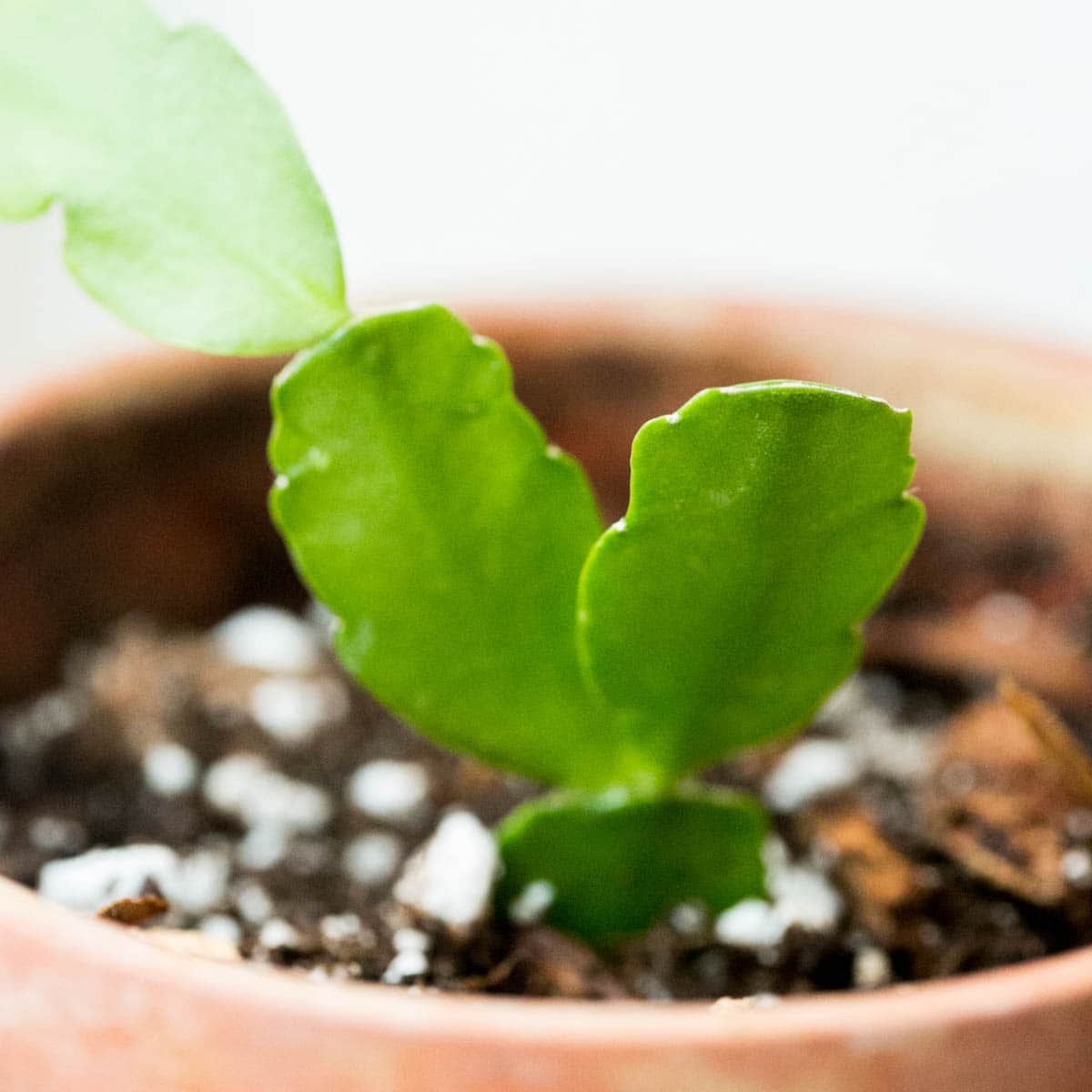
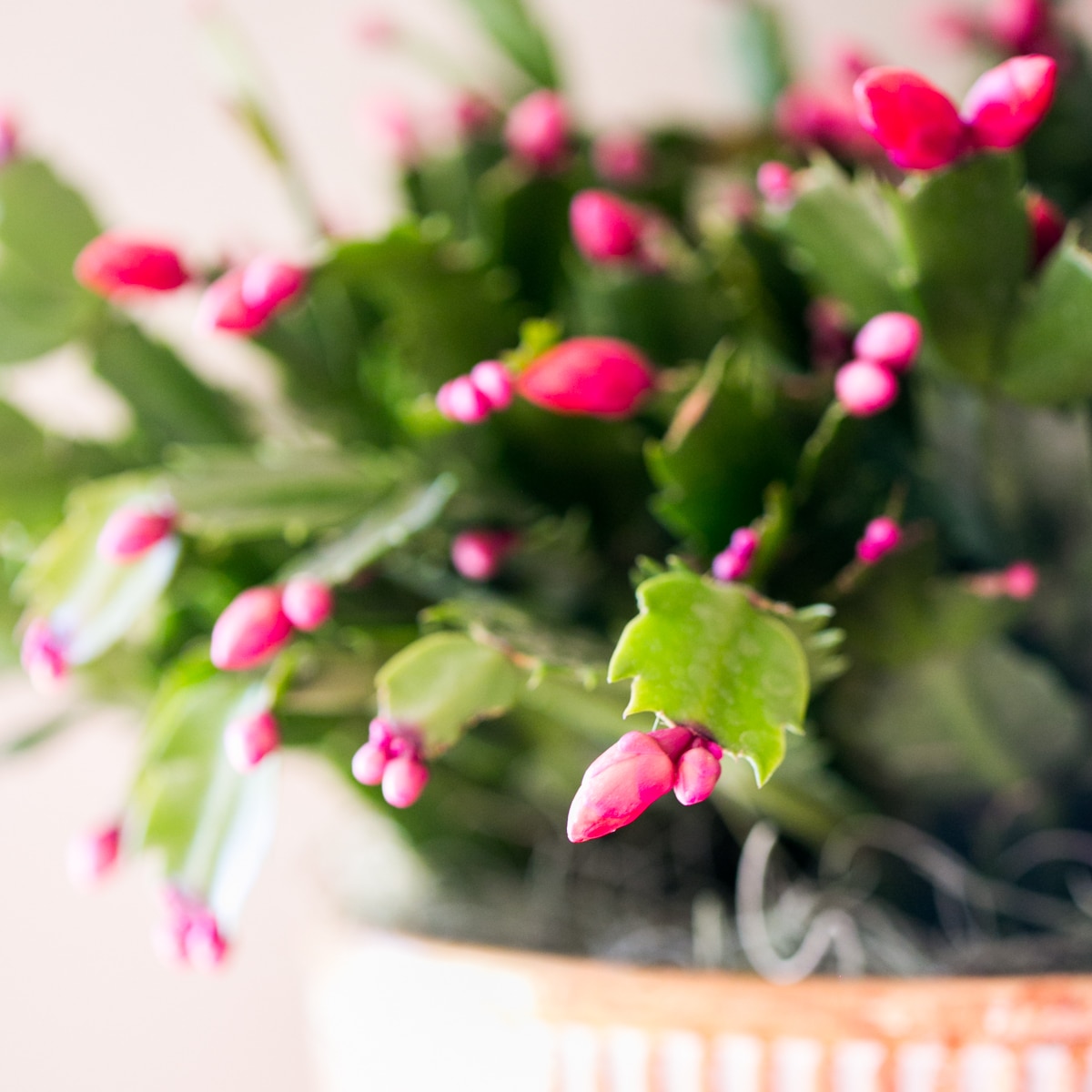
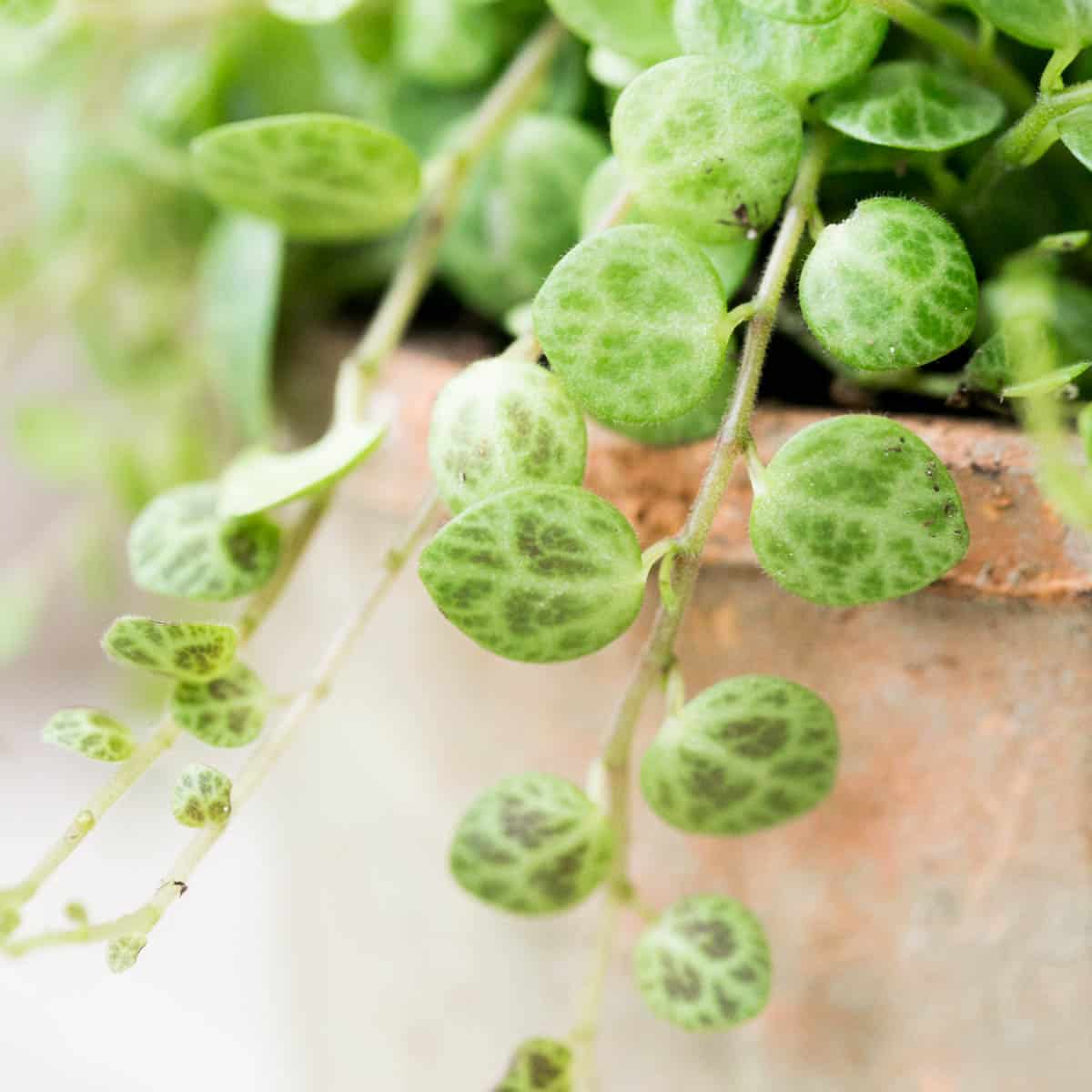
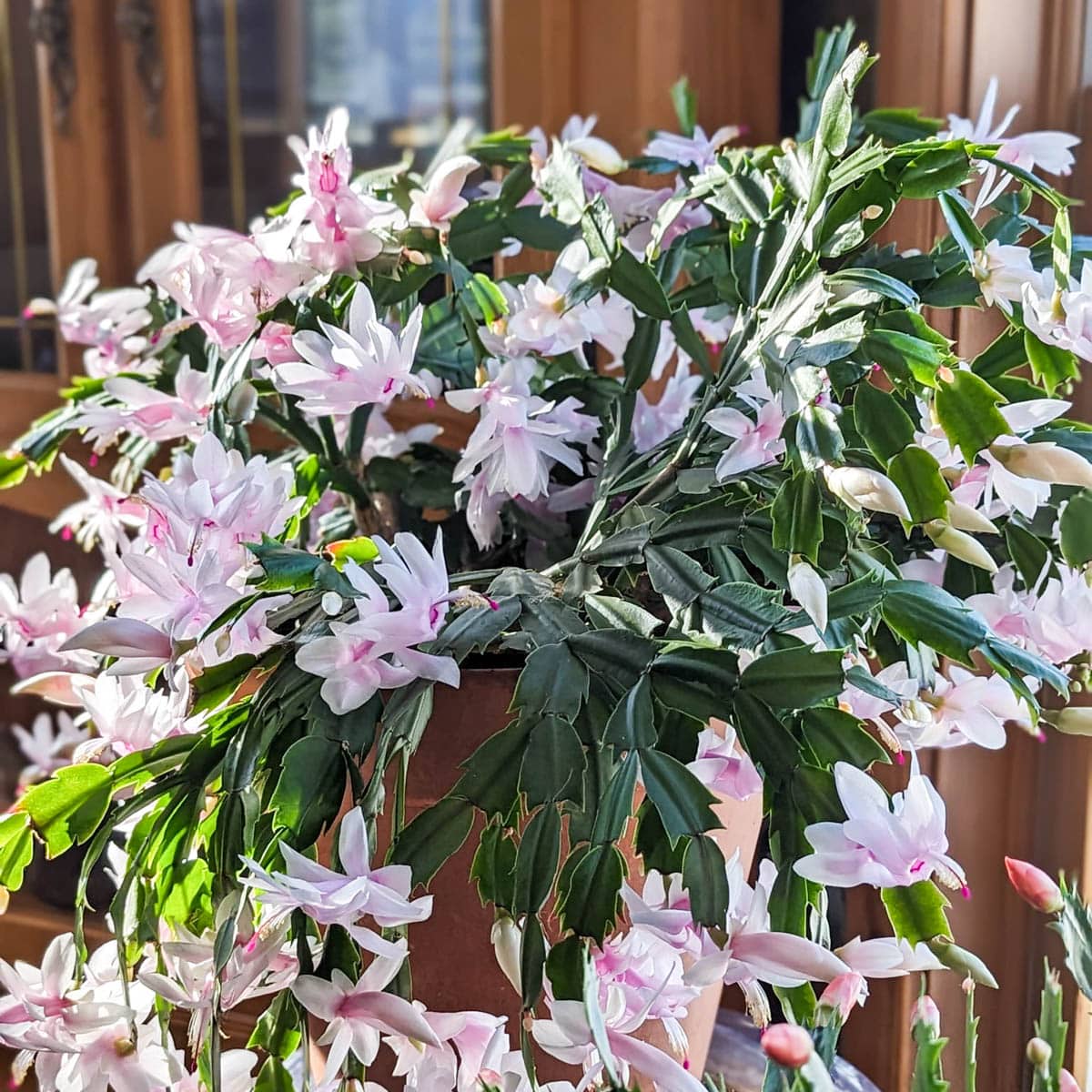
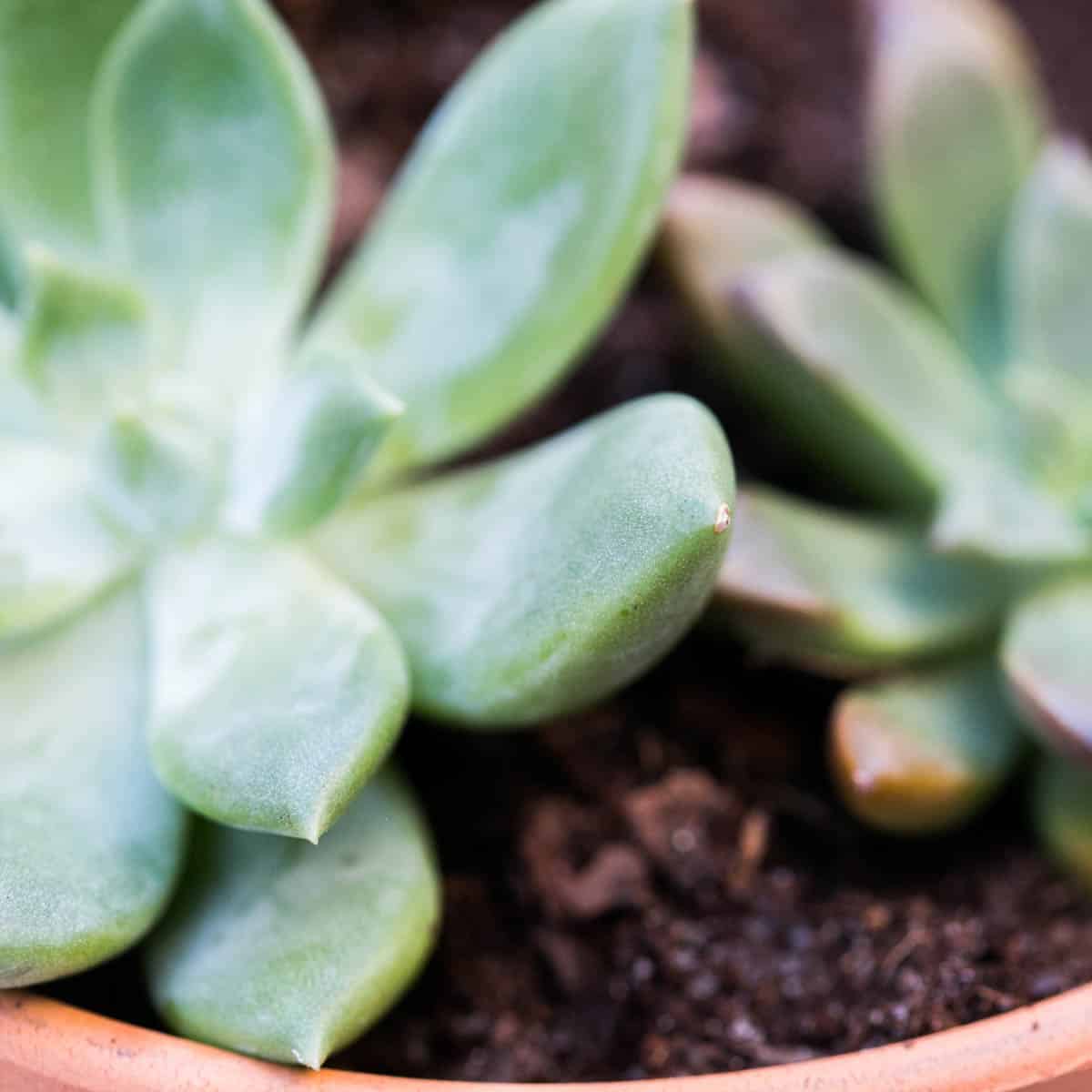
Dear Jamie: Thank you so much for your kindness in sharing this information on proper care of holiday cacti. I didn’t know about the importance of adding pumice, orchid bark, sand and pearlite to the soil. Now that I know, it makes perfect sense. As a child my Mom and Auntie taught me to love gardening and our neighbor Ramona Garcia, who tended a gorgeous 🌹 rose garden, actually took me under her wing and let me get up to my elbows in soil; potting up bulbs and fushias, etc. What a rich experience for a little girl enamored with nature 💕. I am 67 now, and I still keep a patio garden and houseplants. They make me happy and calm my nerves. One last question: I live in a dimly lit apartment, so I try to choose plants which do well in filtered light. My patio, too, is a shade garden. Please give me pointers on keeping begonias and orchids healthy and blooming. Again thank you for all you do. Sincerely, Roberta Puentes.
Hello Roberta! Thank you so much for sharing your experiences with plants! I agree, they are so calming and uplifting. I love how you were encouraged to get into the soil at such a young age-time in nature and with plants as children makes an unforgettable mark upon us. What a gift your aunt, mom and neighbor gave you! I am so happy to hear you have carried this through your whole life. For your orchids, make sure they are kept in warm temperatures, avoid direct light, and keep humidity levels around 50%. When given proper care, orchids should bloom in succession for about 3-4 months.
Thank you again for stopping by, I really enjoyed hearing your story!
I ordered a Christmas Castus which was in soil. The small cactus was not. I put them in potting soil with rocks in the bottom then a mix soil with sand. Will i need to repot . Drainage is good.
Hi Candie! That should be good for now. As your cactus grows you will want to eventually to meet the plant’s size needs. Sounds like your soil mix is and drainage are spot on.
Jamie ,
I was given an older Christmas cacti around a year ago. The chutes were grey and has never bloomed. I cut it back since it was not bloomed. I would love to see these blooms
Hi Jodi,
I am wondering if your plant has Botrytis blight, which is a mold that is pretty detrimental to the plant. I would look into that- the grey on the leaves makes me think it may be this fungus.
Hello, thank you for the great info on the right type of soil to use. I have 2 holiday cactus’s, one is 42 y/o and the other is over 20 y/o. Both in dire need of transplanting. My question is how do you get them out of their existing pot without doing damage to the leaves?
Hi Donna! Transplanting large, established plants can be tricky. In an effort to protect the plant, you can simply replace the first few inches of soil (3-4), this is considered top dressing the soil and give the plant more nutrients.
If you decide to transplant them, make sure to have all your supplies right with you. Enlist the help of friends and go slowly and carefully when lifting out the cactus. If you can squeeze or manipulate the pot, that is better than squeezing the plant! You may lose some of the roots and/or leaves in the process, be sure to water it right away after to support the plant.
Is it ok to fertilize before budding?
Hi Deb,
Yes! Fertilizing in the spring and summer will encourage the buds to set in the fall.
Howdy Jamie , this is deb from Tahlequah Ok….I have been doing houseplants and flowerbeds since I was 4 years old …..I am 67.8 yrs blessed but you have given more thorough step by step information than I ever knew and I am a simple ole gal I try this holiday cactus is very very different than anything I have tried….I have one question only my dirt starts off as miracle grow cacti soil mix is this good or not? I have 30 Thanksgiving cactus plus 3 Christmas and 2 Easter cactus I love them all
Howdy Deb! So good to hear from you. Sometimes simple is better haha! 🙂 I have loved plants for a long time as well. I am updating this comment-I have had several people tell me Miracle gro cactus soil is full of peat moss, which makes the soil retain water and causes it to rot. I would switch to a custom potting soil specifically for Christmas cactus. Sending you an email as well with this update. Thank you so much for visiting and thank you for sharing!
My cactus is approximately 3 feet wide. I want to separate it.. how do I go about that? Thanks in advance
Thank you Jamie, for your knowledge with Christmas cactus.
What is the best pot for them? Can an orchid pot work or does it really matter the size?
Hi June!
Thank you so much! Yes, you can use an orchid pot. Cacti like to be slightly root bound, so you don’t want your plant swimming in a pot. Try to put it in one that seems to just fit the plant’s size.
I must be lucky or something because I’ve had the same Christmas Cactus since 1978! For the last 20+ years it has been rooted in a light fixture with no soil, only water. There is algae growing on the inside surface indicating healthy and not rotting roots. Here’s a link to 2 pictures showing how well it’s doing and the pot it is in. In the picture the water is low. When I water it I fill it to nearly the top. I never let it go dry.
https://photos.app.goo.gl/ptawWgRsBWz3QQ1Q8
Hi Terry! This is so interesting and wonderful to hear! I enjoyed the photos. It would be fun to interview you on growing Christmas cactus in water. If you are interested email me at [email protected]
Dear Jamie, I purchased Dr.Earth cactus and succulent soil mix and I potted my holiday cactus in it. How do you think I should modify this soil to fit my schlumbergera plant?
Hi Regina! I just took a peak at the ingredients on that mix. I would probably add one part indoor potting soil to it.
Your Christmas Cactus is gorgeous! I have had mine for over 20 years. I rooted it in water from a tiny start off a plant at my children’s elementary school.
My girlfriend give me a Christmas Cactus and about three years or more and it was growing very nice I went on vacation for two months and when I came back it die I feel very sad because it was blooming and very full 😢 I was cherish my 🪴 because my friend passed I saw some on a garden show I order one and I bought a next one please tell me how should I take care of them I am seventy five and love plants 🪴 Thank you.
Hi Maureen! I’m so sorry to hear that. We have lots of articles on our site from the best soil to how to prevent overwatering. Click on our holiday cactus tab to read them all. Good luck with our plants!
Please help! After my Mother’s past away last year, I inherited her Thanksgiving/Christmas cacti. One of them was my Grandmother’s! Unfortunately, they are not doing well. The oldest on has very thick stems at the bottom that have no leaves. I am watering them as recommended, but they just don’t look healthy. Suggestions?
Hi Michelle! I would definitely check the soil and see what condition it is in. If the soil is old, it is probably lacking nutrients- which of course will harm the plant. Before amending the soil, I would take a few cuttings and propagate some plants (you can read our recent article on propagation for reference). Thick stems at the base are normal on mature, established plants. Let me know if this helps!
When is the best time to transplant Christmas/ Thanksgiving cacti? I used a cacti Potting soil a few years back, but it always seems to be hard. I try to loose it should I change the soil?
Hi Kathleen! We recommend transplanting your holiday cactus in late winter or early spring. You can change the soil when doing so, it will give your plant a boost of nutrients and help with drainage. Here is our soil recipe: https://greengardencottage.com/best-soil-for-christmas-cactus/